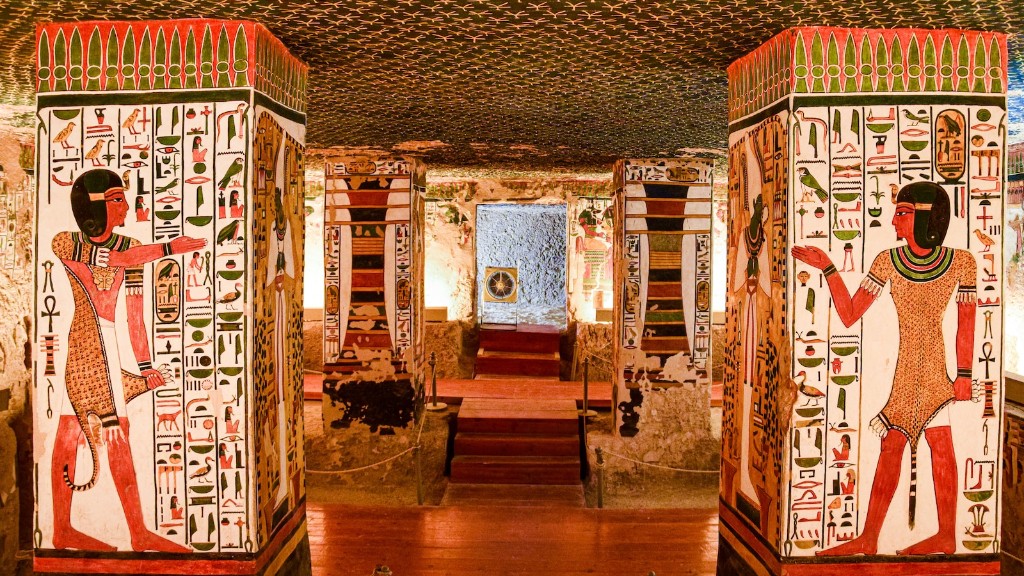Geography and the Rise of Ancient Egypt
The geography of Egypt is a major factor in the rise of one of the oldest civilizations in human history. Ancient Egypt conquered much of the Nile Valley during the period known as the ‘Old Kingdom’, which was from around 2686-2181 BCE. The ability of the Egyptians to survive and thrive in this arid land was due in part to its geography and climate.
The climate of the region is mainly desert, with a long hot summer season. The area receives very little rainfall, making agriculture difficult. However, the Nile River provided a reliable source of irrigation for the fields, and so the Egyptians were able to cultivate crops. The river also provided the beneficial ‘silt’ which made the ground fertile, and so it was relatively easy for the Egyptian civilization to develop.
The geography of the region also had a major influence on the development of the early Egyptian civilization, in two major ways. Firstly, the Nile River made it easier for the Egyptians to travel, and to trade and spread their culture further afield. Secondly, the area around the Nile was somewhat isolated from the rest of the Middle East, allowing the Egyptians to develop a distinct and unique culture.
The other defining element of the geography of ancient Egypt is the desert. The aridity of the desert served as a natural barrier to the Egyptians, protecting them from potential aggressors. The desert was also a source of precious materials such as stone and other resources such as metals, which the Egyptians could use to create tools and weapons.
The geography of ancient Egypt then, was a major factor in the rise of one of the oldest civilizations in human history. The Nile provided a reliable source of irrigation, while the desert provided protection and resources. It is clear that without the geography of the region, the Egyptian civilization would not have survived and would not have become the great civilization that it did.
Geography and the Fall of Ancient Egypt
The ancient Egyptian civilization eventually fell after a period of decline that lasted from the late 13th century to about 1100 BC, lasting up until the introduction of the Non-Native Persian forces in 525 BC. Geography played a pivotal role in this decline, due in large part to the difficulty that the Nile River presented.
The Nile was a double-edged sword, providing so much for the Egyptians, yet presenting so much risk. As the river changed course from time to time, it became increasingly difficult to maintain crop production levels. This, coupled with the fact that Egypt was vulnerable to the vicissitudes of weather and climate, meant that the Egyptians were largely at the mercy of their environment.
In addition, the desert was a major impediment to progress. As the Egyptian civilization declined, it became harder for the Egyptians to access precious resources such as stone and metals. Furthermore, as the desert became more inhospitable, it was increasingly difficult for the Egyptians to maintain any sort of trade with the outside world. This meant that the Egyptian civilization was increasingly isolated, unable to progress and develop as it had once done.
In conclusion, it is clear that the geography of Egypt played a major role in the rise of the old kingdom, and in its eventual decline. The dependance of the Egyptians on the Nile River for irrigation, coupled with the isolation of the desert, made the Egyptian civilization vulnerable to changes in their environment. As such, it is clear that the geography of the region was a major factor in the rise and fall of the great civilization of Egypt.
Geography and the Influence of Ancient Egypt
The geography of ancient Egypt not only had a major impact on the rise and fall of the great civilization, but it also had a lasting and profound influence on the region. It is clear that the culture, art and architecture of the people of Egypt were heavily shaped by the physical landscape of the country.
The Egyptians developed a distinct art style, heavily inspired by the desert around them. The distinctive hieroglyphic writing system was, in part, a result of the isolation created by the desert. The desert also provided resources for the Egyptians to create their stone monuments and temples. The great pyramids and the Sphinx, two of the most famous monuments of the ancient world, were built using massive blocks of stone transported from the desert.
The Nile, too, inspired the ancient Egyptians in their art and architecture. The river was an ever present part of ancient Egyptian life, and many paintings, murals and reliefs featured the Nile and its life-giving waters. The Egyptians also built numerous monuments along the river, such as obelisks and temples, a testament to the importance of the river in their lives and their culture.
Finally, the geography of Egypt inspired the Egyptians to build great cities. The Old Kingdom period saw the rise of numerous cities along the Nile, testifying to the importance of this region of the world to the development of civilization. The cities of Thebes, Memphis and Heliopolis are all examples of this influence, as are the many fortifications that were built to defend them and the land of Egypt.
In conclusion, it is clear that the geography of Egypt had a profound influence on the ancient Egyptians. The desert, the Nile and the cities all served as a source of inspiration for the culture, art and architecture of the people of this great civilization. It was this physical environment that allowed the Egyptians to develop into the powerful and influential civilization that they became.
Geography and the Legacy of Ancient Egypt
The legacy of the ancient Egyptians has had a lasting influence in the world today, and much of this can be attributed to the geography of the region. The geography of Egypt not only allowed the civilization to rise and prosper, but also allowed its culture and ideas to spread further afield.
The Nile was a major factor in this, providing a reliable source of trade and travel for the Egyptians. The river was an important link between the Mediterranean world and the interior of Africa, meaning that the culture of the Egyptians was spread as far as Nubia, an area to the south of Egypt.
The desert too was a major factor in the dissemination of the culture of the ancient Egyptians. The desert was a major source of precious materials and resources, meaning that the Egyptians could develop advanced tools and weapons which they could exchange with their neighbors. It was through this trade that the culture of the Egyptians was spread as far as Greece, southern Italy, and even western Asia.
The legacy of the ancient Egyptians has had a profound influence on the world today. The art and architecture of the ancient Egyptians have been copied in various cultures around the world, and their hieroglyphic writing has been adapted by various cultures such as the Phoenicians and the Greeks. Furthermore, the legacy of the Egyptians has even been felt in modern medicine, with the development of many of the tools and techniques used in modern scientific health care.
In conclusion, it is clear that the geography of Egypt played a major part in the rise and fall of this great civilization, and had an indelible effect on the world today. The Nile and the desert were both major factors in allowing the culture of the Egyptians to spread far and wide, and in allowing the legacy of the ancient Egyptians to live on in the modern world. It is clear that without the geography of Egypt, the world today would be a very different place.
Geography and the Architecture of Ancient Egypt
The architecture of ancient Egypt was heavily influenced by the geography of the region. The arid climate and the long hot summers meant that building materials such as stone had to be sourced from the desert, while the Nile had to be used to bring the necessary supplies and materials to the construction sites. The architecture of the ancient Egyptians also had to take into account the strong winds which sweep through the region, and the potential for flooding in some areas.
The most iconic examples of ancient Egyptian architecture are the Great Pyramid of Giza and the Sphinx, both of which were built for the Pharaoh Khufu in the Old Kingdom period. The Great Pyramid was built using huge blocks of limestone transported from the desert, while the Sphinx was carved from an outcrop of stone. Both of these monuments were constructed with mathematical precision, indicating the skill and knowledge of the ancient Egyptians.
Other examples of ancient Egyptian architecture include the temple complexes of Thebes and Luxor. These complexes demonstrate the technical prowess of the Egyptians, with their intricate reliefs and decorations made of stone, painted wood and metals. Again, these monuments had to be constructed using materials from the desert and with the strong winds in consideration.
Finally, the Egyptians also developed a distinctive style of architecture for their cities, particularly along the Nile. Homes in these cities were built of mud brick and were often built in a spiral pattern, which allowed them to be protected from the strong winds. The walls of the cities were also heavily fortified to protect them from potential enemies.
In conclusion, it is clear that the geography of Egypt had a major influence on the architecture of the ancient Egyptians. The desert provided the resources, while the Nile had to be taken into consideration when building structures. The architecture of the Egyptians was a testament to their technical knowledge, and the legacy of their architecture can still be seen today.
Geography and the Social Structure of Ancient Egypt
The geography of Egypt also had a profound influence on the social structure of the ancient civilization. The river Nile was the source of food and water for the people of Egypt, and so it was of utmost importance to the functioning of the society. The river also served as a source of travel, allowing the Egyptians to trade and interact with other cultures.
In addition, the desert was also of great importance to the social structure of the Egyptians. The desert was a major source of resources such as stone and metals, which allowed the Egyptians to build monuments and cities. The desert was also a source of power, and allowed the Pharaohs to maintain control over the people of Egypt.
The geography of Egypt also affected the social roles within the society. For example, people living close to the Nile were able to make the most of the waters and so were more prosperous than those living in the desert. Similarly, those living close to the desert had a great deal of power, due to their access to resources such as stone and metals. This caused a bifurcation of the social classes, with the wealthy and powerful living close to the beneficial river, while the poor and powerless lived in the harsh desert.
In conclusion, it is clear that the geography of Egypt had a major influence on the social structure of the civilization. The Nile and the desert both played an important part in allowing the Pharaohs to maintain control, and in giving some of the population a greater sense of power and prosperity. The social structure of the ancient Egyptians was heavily shaped and influenced by the physical environment in which they lived.





